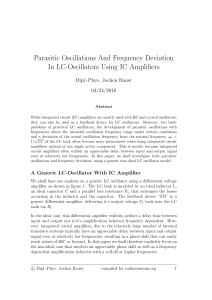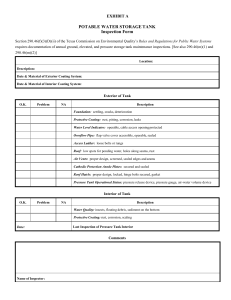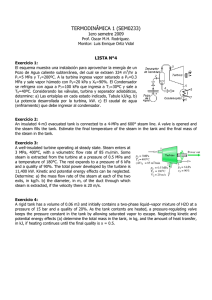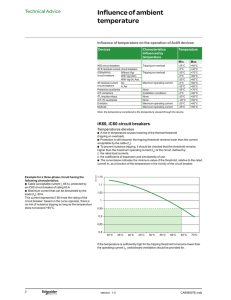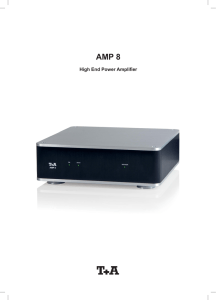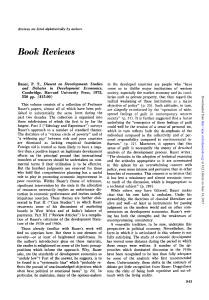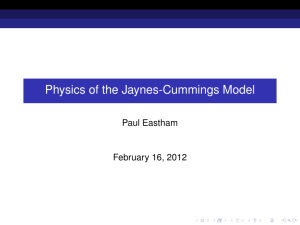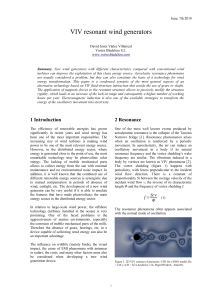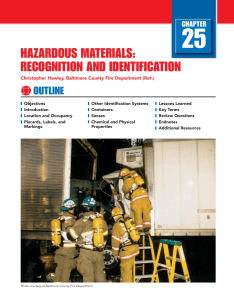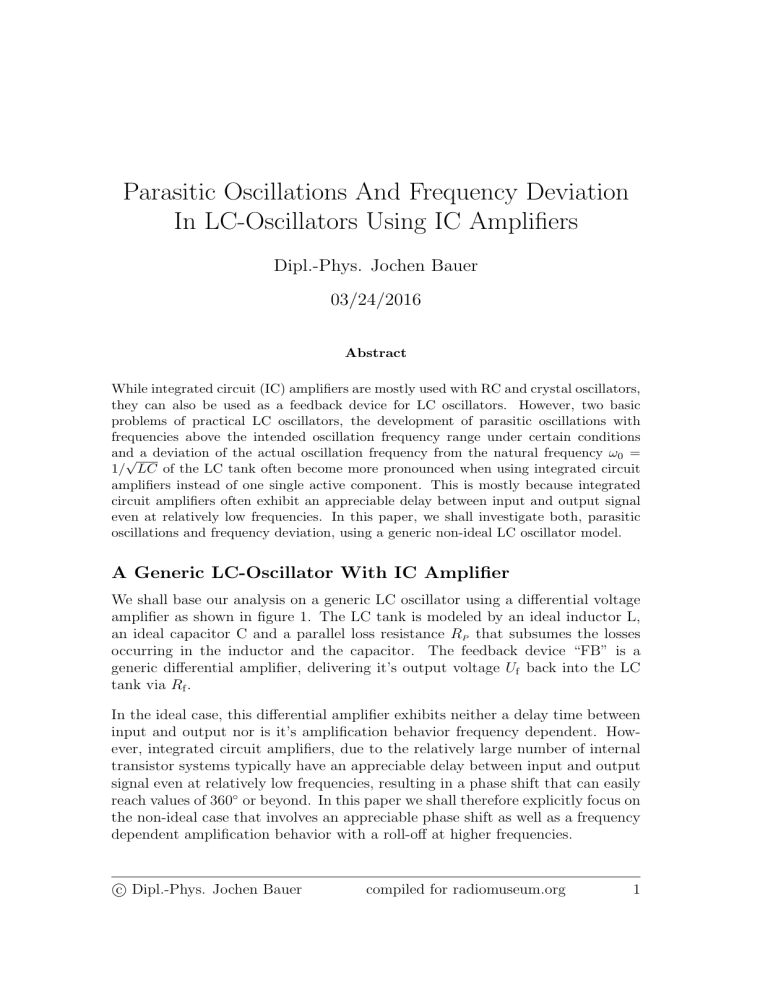
Parasitic Oscillations And Frequency Deviation In LC-Oscillators Using IC Amplifiers Dipl.-Phys. Jochen Bauer 03/24/2016 Abstract While integrated circuit (IC) amplifiers are mostly used with RC and crystal oscillators, they can also be used as a feedback device for LC oscillators. However, two basic problems of practical LC oscillators, the development of parasitic oscillations with frequencies above the intended oscillation frequency range under certain conditions and √ a deviation of the actual oscillation frequency from the natural frequency ω0 = 1/ LC of the LC tank often become more pronounced when using integrated circuit amplifiers instead of one single active component. This is mostly because integrated circuit amplifiers often exhibit an appreciable delay between input and output signal even at relatively low frequencies. In this paper, we shall investigate both, parasitic oscillations and frequency deviation, using a generic non-ideal LC oscillator model. A Generic LC-Oscillator With IC Amplifier We shall base our analysis on a generic LC oscillator using a differential voltage amplifier as shown in figure 1. The LC tank is modeled by an ideal inductor L, an ideal capacitor C and a parallel loss resistance RP that subsumes the losses occurring in the inductor and the capacitor. The feedback device “FB” is a generic differential amplifier, delivering it’s output voltage Uf back into the LC tank via Rf . In the ideal case, this differential amplifier exhibits neither a delay time between input and output nor is it’s amplification behavior frequency dependent. However, integrated circuit amplifiers, due to the relatively large number of internal transistor systems typically have an appreciable delay between input and output signal even at relatively low frequencies, resulting in a phase shift that can easily reach values of 360◦ or beyond. In this paper we shall therefore explicitly focus on the non-ideal case that involves an appreciable phase shift as well as a frequency dependent amplification behavior with a roll-off at higher frequencies. c Dipl.-Phys. Jochen Bauer compiled for radiomuseum.org 1 Rf If U IL L IC C IRp + FB − Rp Uf Figure 1: Generic LC oscillator Linear Approach A basic understanding of the behavior of the oscillator with phase shifted feedback can be obtained by going below the oscillation threshold and analyzing the response of the feedback device when driven externally by a small sinusoidal input voltage using complex phasors. We shall therefore, for now, remove the LC tank from the circuit while keeping it’s parallel loss resistance RP in place and take a look at the input current IIN resulting from a driving voltage UIN as depicted in figure 2. IIN UIN Rf If IRp + FB − Rp Uf Figure 2: Feedback device in linear phasor analysis Using Kirchhoff’s circuit laws [1], we obtain URf + UIN = Uf c Dipl.-Phys. Jochen Bauer and IIN + If = IRP compiled for radiomuseum.org 2 In the linear approach, the feedback voltage is related to the input voltage by Uf = aUIN where a is the small signal amplification factor of the feedback device. Using Ohm’s law, these equations yield 1 a 1 + − UIN IIN = RP Rf Rf from which the input impedance follows to be −1 1 1 a −Rf ZIN = + − = RP k Rf k RP Rf Rf a where Z1 kZ2 denotes impedances connected in parallel. The fact that Rf contributes to the input impedance can easily be understood by bearing in mind that the feedback device is assumed to have zero output impedance, hence RP and Rf are connected in parallel. As expected, positive feedback (a > 0) creates a negative virtual parallel loss resistance −Rf /a. If this negative resistance over-compensates the losses in the tank, i.e. 1 a 1 + − <0 RP Rf Rf the circuit will start to oscillate. We can now easily introduce a phase shift ϕ between input and output voltage of the feedback device by using a complex amplification factor of the form ae−jϕ . By putting a negative sign into the exponent, we imply that the output lags behind the input and we have ϕ > 0 for the remainder of this paper. Replacing a with ae−jϕ in the above equations immediately yields −1 1 a cos ϕ a sin ϕ −Rf −jRf 1 = RP k Rf k + − +j k ZIN = RP Rf Rf Rf a cos ϕ a sin ϕ Obviously, a phase shift ϕ occurring in the feedback device has two effects: First, the additional parallel resistance −Rf /a cos ϕ introduced by the feedback device now depends on the phase shift ϕ and can also assume positive values, i.e. the feedback device delivers negative feedback into the tank causing damping. Second, a virtual parallel reactance −jRf /a sin ϕ is introduced into the tank causing detuning, √ i.e. the actual oscillation frequency deviates from the natural frequency ω0 = 1/ LC of the tank. In case of sin ϕ > 0 the tank will be detuned towards lower frequencies (virtual parallel capacitance) while in case of sin ϕ < 0 the tank will be detuned towards higher frequencies (virtual parallel inductance). Let us now focus on the oscillation conditions of the circuit as predicted by the linear approach. From the above equation for ZIN the oscillation condition is found to be c Dipl.-Phys. Jochen Bauer compiled for radiomuseum.org 3 1 a cos ϕ 1 + − <0 RP Rf Rf In all practical feedback devices, the phase shift between input and output voltage as well as the small signal amplification factor depend on the frequency of the oscillations. Hence we are actually dealing with ϕ(ω) and a(ω). With ω increasing, a(ω) will typically decrease while ϕ(ω) increases. In fact, ϕ(ω) will go beyond 360◦ when the delay time between input and output exceeds one period of the input signal. A necessary condition for the circuit to oscillate is obviously cos ϕ(ω) > 0, i.e. oscillations can potentially occur at frequencies where 0◦ < ϕ(ω) < 90◦ or 270◦ < ϕ(ω) < 450◦ or 630◦ < ϕ(ω) < 810◦ and so on. However, for oscillations to actually occur, a(ω) must still be high enough to fulfill the oscillation condition stated above. The property that oscillations can occur at higher frequencies where ϕ(ω) is above 270◦ can e.g. be used in microwave oscillators using delay lines. However, in oscillators using an LC tank this behavior is generally undesired since it may cause oscillations near parasitic resonant frequencies of the circuit connected to the feedback device.1 In this paper, we shall therefore regard oscillations beyond the primary oscillation range (0◦ < ϕ(ω) < 90◦ ) as undesired parasitic oscillations. General Non-Linear Treatment While the linear approach has certainly given us a valuable qualitative insight into the behavior of the oscillator, it’s quantitative applications are limited. This is simply because oscillators are non-linear by nature and a time domain analysis using differential equations is necessary. Since in the non-linear time domain approach we cannot simply put a phase shift between the input and output phasor of the feedback device as we did in the linear approach, we will need a suitable non-linear circuit model of the feedback device to continue. Let’s start by looking at the required properties of the feedback device model. First of all, the output voltage Uf of the feedback device needs to be bounded. Also, Uf should exhibit an approximately linear dependency on the input voltage for sufficiently small input voltages at low input frequencies. Therefore, a good starting point is the non-linear feedback device introduced in [2] with the current output replaced by a voltage output. What we need to do now, is to augment this feedback device model by a time delay mechanism (resulting in the desired phase shift) and low-pass properties so that the small signal amplification factor a(ω) decreases as the frequency rises. This can simply be achieved by preceding 1 When taking parasitic inductances and capacitances on the circuit board and in the components into account, the LC tank connected to the input √ becomes an intricate LC network with several parasitic resonant frequencies above ω0 = 1/ LC. c Dipl.-Phys. Jochen Bauer compiled for radiomuseum.org 4 the non-linear feedback device with a cascade of n RC low-pass filters that are mutually separated by ideal2 unity gain amplifiers as shown in figure 3. + U + R1 a=1 − R2 a=1 − C1 U U1 U1 C2 ... U2 ... ... + ... a=1 − + Rn − Un-1 Cn Un Uf=h(Un) Figure 3: Non-linear feedback device with delay As mentioned above, the last stage of this feedback device is an ideal controlled voltage source similar to the ideal controlled current source used in [2] whose output voltage Uf is given by Uf = h(Un ) = a1 arctan(a2 Un ) and which therefore has a small signal gain of a0 = h0 (0) = a1 a2 . The reader is referred to [2] for a more detailed discussion of the properties of this feedback function. Phase Shift And Gain Before we start deriving the differential equations governing the generic LC oscillator from figure 1 using the feedback device model from figure 3, let us do a small signal linear analysis of this feedback device model. Using phasors, it is easily shown that for a driving voltage of frequency ω, the phase shift of each 2 Infinite input impedance, zero output impedance c Dipl.-Phys. Jochen Bauer compiled for radiomuseum.org 5 RC low-pass is given by arctan(ωτk ) where τk = Rk Ck is the time constant of the RC low-pass. Since the RC low-pass filters are mutually separated by unity gain amplifiers, the overall phase shift is ϕ(ω) = n X arctan(ωτk ) k=1 Also the voltage attenuation factor of each RC low-pass filter is readily obtained to be ((ωτk )2 + 1)(1/2) resulting in a frequency dependent gain factor of the feedback device of a(ω) = a0 · n Y 1 p k=1 (ωτk )2 + 1 where a0 is the small signal gain factor of the last stage as introduced in the previous section. The overall small signal phase shift and relative gain factor a(ω)/a0 for τk = τ = 9ns and n = 20 for a frequency range between 100kHz and 10MHz have been plotted in figure 4. Figure 4: Phase shift and relative gain The frequency ranges where the feedback device, according to the phase shift ϕ in the linear analysis, delivers positive resp. negative feedback into the LC tank have been marked accordingly in the diagram. Let us at this point recall the linear analysis of the oscillation condition: The circuit can oscillate in those frequency ranges where positive feedback is delivered into the LC tank and the gain a(ω) of c Dipl.-Phys. Jochen Bauer compiled for radiomuseum.org 6 the feedback device is still sufficiently high to lead to a slight over-compensation of the losses in the tank. Hence, for too high a small signal, low frequency gain factor a(ω → 0) = a0 , the circuit will not only be able to oscillate in the primary (intended) frequency range from approximately 100kHz to 1200kHz, but will also be prone to parasitic oscillations in the positive feedback frequency range around 6000kHz as can be seen from figure 4 Time Domain Analysis Let’s take a closer look at the generic LC oscillator from figure 1 using the feedback device model given in figure 3. Using Kirchhoff’s laws [1], we obtain If (t) = IL (t) + IC (t) + IRP (t) Uf (t) = h(Un (t)) = URf (t) + URP (t) U (t) = UL (t) = UC (t) = URP (t) as well as U (t) = UR1 (t) + U1 (t) U1 (t) = UR2 (t) + U2 (t) .. . Un−1 (t) = URn (t) + Un (t) Using IRk (t) = Ck U̇k (t) the second set of equations is readily rewritten as U (t) = U1 (t) + τ1 U̇1 (t) U1 (t) = U2 (t) + τ2 U̇2 (t) .. . Un−1 (t) = Un (t) + τn U̇n (t) (1) with τk = Rk Ck . Also, differentiating the first equation in the first set with respect to time yields I˙L (t) + I˙C (t) + I˙RP (t) − I˙f (t) = 0 which immediately leads to 1 d URf (t) 1 U (t) + C Ü (t) + U̇ (t) − =0 L RP dt Rf Using URf (t) = h(Un (t)) − URP (t) = h(Un (t)) − U (t) from the first set and bearing in mind that c Dipl.-Phys. Jochen Bauer compiled for radiomuseum.org 7 d h(Un (t)) = h0 (Un (t)) · U̇n (t) dt we finally arrive at 1 1 1 1 1 h0 (Un (t)) · Un (t) = 0 (2) Ü (t) + 2 + U̇ (t) + U (t) − 2 2 ω0 ω0 C RP Rf ω0 Rf C √ with ω0 = 1/ LC. Equation (2) along with equation set (1) completely govern the behavior of the circuit for all feedback functions h(Un ) of the last stage of the feedback device model and any number n of RC low-pass filters. However, we shall continue to use h(Un ) = a1 arctan(a2 Un ) along with n = 20 as we did earlier in this paper. Like with most non-linear differential equations we have to resort to a numerical analysis at this point. Let us start by setting the parameters that will not change during the remainder of this paper. These shall be a1 = 10, thereby limiting the output voltage of the feedback device to approximately ±15V, Rf = 100kΩ and τk = τ = 9ns 3 for all RC low-pass filters, equivalent to a cut-off frequency of approximately 18MHz which is well above the frequency range of 100kHz to 10MHz that we are going to look at. An obvious issue when covering a large frequency range is the L/C ratio of the tank. In order to not end up with unreasonable L/C ratios, we shall use a constant ratio of L/C = 630µH/nF over the entire frequency range 4 . Furthermore, the parallel loss resistance RP is a rather non-intuitive quantity and it may be desirable to replace RP by the Q-factor of the LC tank by virtue of [3] RP = p Q L/C. Parasitic Oscillations We shall now focus on the occurrence of parasitic oscillations above the primary (intended) oscillation frequency range. The preceding linear analysis of the circuit has already given us an idea of what to expect in terms of parasitic oscillations. However any linear treatment of a highly non-linear system like an oscillator will typically fail to make decent quantitative predictions and we need to resort to numerically solving the non-linear differential equations governing the circuit in order to obtain reasonable quantitative results. For this purpose, we have used LSODE [4]. 3 The resulting phase shift behavior is roughly similar to the phase shift behavior of an LM311 comparator at frequencies belowq5MHz. 4 This obviously implies that C = c Dipl.-Phys. Jochen Bauer 1 ω0 C L ≈ 1 ω0 · 1.26 · 10−3 Fs in equation (2) compiled for radiomuseum.org 8 From the linear analysis of the circuit, we know that the value of the small signal, low frequency gain factor a0 of the feedback device is crucial for the occurrence or absence of parasitic oscillations. We shall therefore investigate the occurrence of oscillations √ and their amplitude for different values of a0 as the natural frequency ω0 = 1/ LC of the tank moves over a wide range from 100kHz to 10MHz 5 . This has been done in figure 5 by numerically solving the differential equations governing the circuit with parameters as specified so far in this paper and assuming a moderately high Q-factor of the LC tank of Q = 80. Figure 5: Occurrence of oscillations Obviously, for a high gain of a0 = 200000 6 (red curve) the circuit will oscillate not only when the natural frequency of the LC tank is below approximately 1.4MHz but also when the natural frequency is in a range around 6MHz7 In practical oscillator circuits with the intended natural frequency of the LC tank set below 1.4MHz this may cause undesired oscillations near parasitic resonant frequencies of the circuit around 6MHz. This unfavorable behavior persists even 5 The reader is reminded that a0 is related to the parameters a1 and a2 of the feedback model by a0 = a1 a2 and after setting a1 can be set by choosing a2 . 6 This is roughly the open-loop gain of an LM311 voltage comparator. 7 The reader may have noticed that even in the frequency range around 3MHz where the linear approach predicts no oscillations at all, the amplitude curve indicates some residual oscillations. A deeper investigation reveals non-sinusoidal oscillations with frequencies jittering between the primary and parasitic oscillation frequency range. This is clearly a non-linear phenomenon of the circuit. c Dipl.-Phys. Jochen Bauer compiled for radiomuseum.org 9 down to a0 = 10 (green curve) although the amplitude of the oscillations around 6MHz now becomes somewhat smaller than the amplitude of the oscillations below approximately 1100kHz. Finally, at a0 = 5 (blue curve) the oscillator is left with only one oscillation frequency range ending at approximately 800kHz. This rules out parasitic oscillations above the intended frequency range and can be considered a stable oscillator design. Frequency Deviation We shall now turn our attention to √ the deviation of the oscillation frequency ωosc from the natural frequency ω0 = 1/ LC of the LC tank. From the linear analysis of the circuit we have learned that this is due to a virtual parallel reactance appearing across the LC tank due to feedback. Here, we are interested in the frequency deviation occurring in the primary oscillation range, where in the linear approach, 0◦ < ϕ < 90◦ and hence ωosc < ω0 due to the appearance of a virtual capacitance. Again, the linear approach has given us a qualitative idea of what is going to happen. However for reasonable quantitative results, we again need to resort to numerically solving the non-linear differential equations (1),(2). Since the linear approach predicts that the absolute value of the virtual parallel reactance will increase with the gain factor of the feedback device necessary to sustain the oscillations, we expect the frequency deviation ∆ω = ωosc − ω0 to depend on the Q-factor of the LC tank and we shall therefore numerically investigate the deviation of the oscillation frequency for different Q-factors of the LC tank over a natural frequency range from 100kHz to 800kHz which is well inside the primary oscillation range. The results of this analysis have been plotted in figure 6. As expected, the oscillation frequency ωosc is below the natural frequency ω0 of the LC tank and we see a pronounced dependency of the frequency deviation ∆ω = ωosc − ω0 on the Q-factor of the LC tank. The plot in figure 6 has been created using a very high small signal, low frequency gain factor of the feedback device of a0 = 200000. However, it turns out that the frequency deviation curve actually depends very little on a0 and the curves for a0 down to a0 = 5 are practically identical to the curve shown. This behavior can be attributed to the fact that for high gain factors, the feedback device will be in saturation and hence inactive for most of the cycle, i.e. frequency skewing occurs only for a short time within each cycle. As the small signal gain factor decreases, the feedback device will have a smaller detuning effect but will be active (i.e. not in saturation) for a longer time within each cycle. c Dipl.-Phys. Jochen Bauer compiled for radiomuseum.org 10 Figure 6: Frequency deviation References [1] http://en.wikipedia.org/wiki/Kirchhoff’s circuit laws [2] http://www.radiomuseum.org/forumdata/upload/regandosc rel.pdf [3] http://en.wikipedia.org/wiki/Q factor [4] K. Radhakrishnan and A. C. Hindmarsh, ”Description and Use of LSODE, the Livermore Solver for Ordinary Differential Equations,” LLNL report UCRLID-113855, December 1993. c Dipl.-Phys. Jochen Bauer compiled for radiomuseum.org 11
